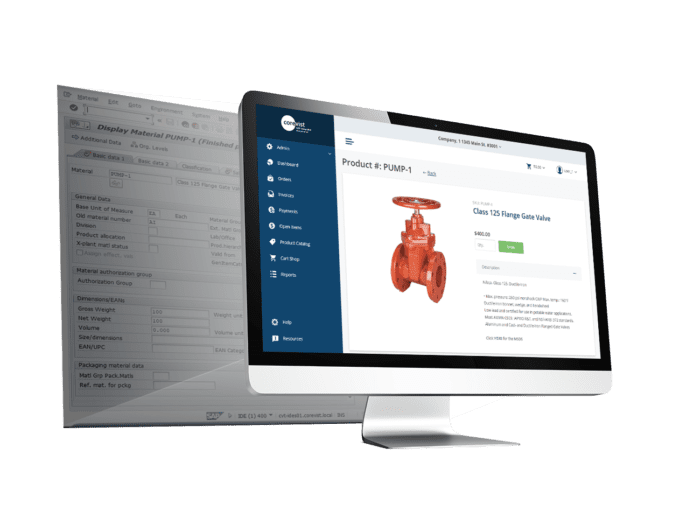
Most B2B eCommerce solutions treat ERP integration as an afterthought.
Not all leading B2B eCommerce platforms were built to play nicely with your ERP. The conventional B2B platform wants total ownership of your business data for transactions, products, customers, and more.
Yet that information already lives in your ERP. The cost and effort to keep these systems integrated, not to mention support them, can threaten the viability of your B2B eCommerce solution.
What if you could launch B2B eCommerce with prebuilt ERP integration?
Imagine a B2B eCommerce solution that includes prebuilt, configurable ERP integration for your SAP system.
Your customers would always get 100% accurate contract pricing, inventory availability, and more—all with no additional effort from your IT team (and no need to keep multiple systems synchronized).

Welcome to the Corevist Platform.

B2B eCommerce with ERP integration included.
Corevist is a next-generation B2B eCommerce solution that starts with your ERP data and works outward. Our platform is built on an out-of-the-box, configurable ERP integration for SAP. This empowers us to drive personalized experiences for your B2B customers—using your ERP business rules, without duplication or synchronization.
Why Corevist for B2B eCommerce + ERP Integration?
You won’t find our approach anywhere else:
✓ Day One Integrated. Our B2B eCommerce solutions include prebuilt, configurable ERP integration for SAP. There’s no need to map your ERP data in middleware or B2B eCommerce.
✓ Launch it tomorrow. Launch it tomorrow. Because our ERP integration is prebuilt, your B2B eCommerce solution is live on Day 1. We spend the next 90 days refining it for your needs.
✓ We’ve got your back. We implement, manage, and support the entire stack for your ERP-integrated B2B eCommerce solution. We stick around for the long haul.


Increased efficiency which you won’t find elsewhere.
Only Corevist eliminates the cost, risk, and complexity of systems and processes which sit between your orders and your ERP.
- Don’t have a platform? Corevist eliminates the expense and risk of phone, fax, and email ordering.
- Got a platform without ERP integration? Corevist eliminates the need to rekey B2B eCommerce orders into the ERP.
- Got a platform with middleware integration? Corevist cuts the cost and complexity of supporting this architecture.
Flexible B2B eCommerce.
Deep ERP integration included in every edition.
Start with the functionality you need today, then expand when you’re ready.
B2B eCommerce Case Study:

- Agricultural and forestry equipment manufacturer
- 1001-5000 employees
- Needed B2B solution integrated to ERP
- IT staff already at capacity
Oregon Tool needed to launch B2B eCommerce with ERP integration using the most efficient architecture they could find. IT couldn’t take on any new burden, so prebuilt integration was critical to success.
Learn how Corevist delivered 325% revenue growth.
Read the case study →
Real time ERP integration: Why it matters in B2B eCommerce
In a B2B eCommerce scenario, ERP integration works best in real time. We say that after 13 years of implementing our B2B eCommerce solutions with prebuilt ERP integration. We’ve heard the horror stories, and we’ve worked with our clients at the front lines of ERP-integrated B2B ecommerce. We know what works and what doesn’t—and we know what’s most expensive in the long run.
We recommend real-time ERP integration in almost every case. Here’s why.
Live ERP data for 100% error-free B2B eCommerce orders
A real-time integration (like the one that comes with the Corevist Platform) will query your SAP system automatically. When a customer goes to place a self-service order through the B2B eCommerce portal, Corevist asks your ERP system, “is this order 100% perfect?”
If SAP returns any error messages, the Corevist Platform displays those messages to the customer. The customer must correct those errors before Corevist will accept the order and post it to SAP.
This stands in stark contrast to batch-sync B2B eCommerce. In a batch-integrated ERP scenario, order errors don’t show up until the batch sync happens—and possibly not until a Customer Service Rep goes to fulfill the order.
It’s not a big deal if you’re processing 1 or 2 orders a day. But for large corporations processing orders at scale, it gets expensive—fast.
A real-time B2B eCommerce/ERP integration eliminates this issue. That’s a huge cost savings and increase in efficiency.
Live ERP data for inventory availability in B2B eCommerce
This one falls in the order error category as well. When your ERP integration architecture depends on batch updates to and from the ERP system, you have absolutely no way to give your B2B customers real-time data on inventory availability.
This can have catastrophic consequences in markets that depend on accurate inventory data. For example, a manufacturer selling emergency supplies to humanitarian organizations needs to show accurate data. If a non-profit needs 100,000 water bottles yesterday, they need to know when they place that order that they’ll get the amount they ordered.
Of course, inventory availability isn’t always a simple calculation. In fact, depending on the ERP configuration, the relevant available-to-promise calculations may be quite complex. But whatever the business rules in the ERP system, a B2B eCommerce store that displays calculated availability in real time eliminates friction in the ordering and fulfillment process.
Live ERP data for contract pricing
This is critical in B2B eCommerce. B2B customer relationships often involve negotiated pricing that’s spelled out in a contract. Since complex business rules governing contract pricing already live in the ERP system, it doesn’t make sense to rebuild them in ecommerce. Rather, it’s best to build ecommerce as a “real-time window” over the ERP system—displaying contract pricing live, in real time, for the logged-in customer.
Live ERP data for minimum order quantity
This is especially important in B2B. Unlike B2C, B2B often involves purchasing directly from a manufacturer who may not want to ship in units of 1, 2, or even 5. It all depends on the product, its manufacturing process, and what quantities are most efficient for the manufacturer to ship.
Here are some typical order quantity constraints that we see in B2B. These are just examples from a wide variety of products across numerous industries.
- Product has a minimum order quantity of 10. Any number over 10 is acceptable. (Rationale: the manufacturer wants to move more product)
- Product can only be ordered in multiples of 10. 10, 20, 30 are acceptable quantities, but 32 is not. (Rationale: the product ships in pallets of 10 units to a pallet. The manufacturer does not want to break up pallets of product.)
- Product has a minimum and maximum order quantity. The customer must order a quantity within the limits. (Rationale: the manufacturer does not want to ship small quantities but also wants to distribute product intelligently among multiple high-volume customers.)
Whatever rules constrain the purchase quantity of a product, that data lives in the ERP system. Why rebuild those complex rules in ecommerce? Rather, the ERP data should carry forward to ecommerce through a real-time integration.
Live ERP data for product restrictions
In B2B, not every customer is allowed to buy every product that’s in the ERP system. Companies that don’t have ecommerce typically handle this with a human touch—a Customer Service Rep has to ensure that the customer is allowed to order the product they’ve requested. But a human touch doesn’t scale well. For B2B companies doing ecommerce to improve efficiency, a different solution is needed.
The answer is live ERP data in the ecommerce store regarding product restrictions. These restrictions are mapped to the ecommerce user’s account and ensure that the customer doesn’t try to order something that isn’t available in their country, sales area, or product line.
Live ERP data for credit limits
Here’s where a real-time ERP ecommerce integration really shines. B2B customers often buy on account, with net 30 invoicing (or similar). Different B2B customers may have different credit limits spelled out in their contract with the manufacturer or distributor.
A real-time check of ERP data is crucial for detecting orders that would put the customer over their credit limit. This type of integration can notify the customer immediately, within the ecommerce user experience, that they need to go pay down a few invoices before they can place their current order.
Imagine depending on batch sync to detect credit issues. Now the order has already been placed, so the customer thinks it’s headed to fulfillment. A Customer Service Representative has to reach out, explain the credit overage, and ask the customer to pay it down.
Again, this is fine if the manufacturer is only processing 1-2 orders a day. But at scale, for large global corporations, it’s a nightmare. It’s much simpler to integrate ecommerce to ERP in real time, empowering customers to perform self-service credit maintenance.
Live ERP data for omnichannel order tracking
Once a company launches ecommerce, they drive up customer expectations. We’re all used to the Amazon experience, which includes logging on and easily seeing whether an order has shipped yet.
In both B2B and B2C, it’s crucial to offer this kind of order-tracking visibility to your customers. But that order tracking portal isn’t much good if it doesn’t talk to the ERP system in real time. Otherwise, it’s at risk of displaying outdated information, which runs counter to the whole purpose of order tracking. Once again, batch sync is not a satisfactory solution.
Live ERP data for simplified architecture
Really, everything we’ve listed so far falls under this umbrella. You can simplify each of these ecommerce data domains by integrating it to the ERP system in real time. That’s what the Corevist Platform does.
We think it’s pretty simple. We put it this way:
- If it’s built in the ERP system, that’s where it should stay. Why duplicate?
This simplified architecture means less maintenance, fewer headaches, and fewer bug fixes. It’s a win-win for everyone involved.
Speaking of which…
Live ERP data requires no additional IT staff
A real-time ERP ecommerce integration offers one more benefit. It’s easy on existing IT staff. In fact, a real-time integration is so seamless and efficient, 1/3 of all Corevist clients have no dedicated staff on payroll to maintain the ecommerce store.
That’s a huge gain in efficiency. With IT resources freed up from troubleshooting ecommerce, you can reassign them to more pressing problems and let the ecommerce machine run itself.

Thinking about your journey?
Let’s put a stake in the ground.
Schedule a consultation with a specialist, and let’s define your path forward with ERP-integrated B2B eCommerce.

